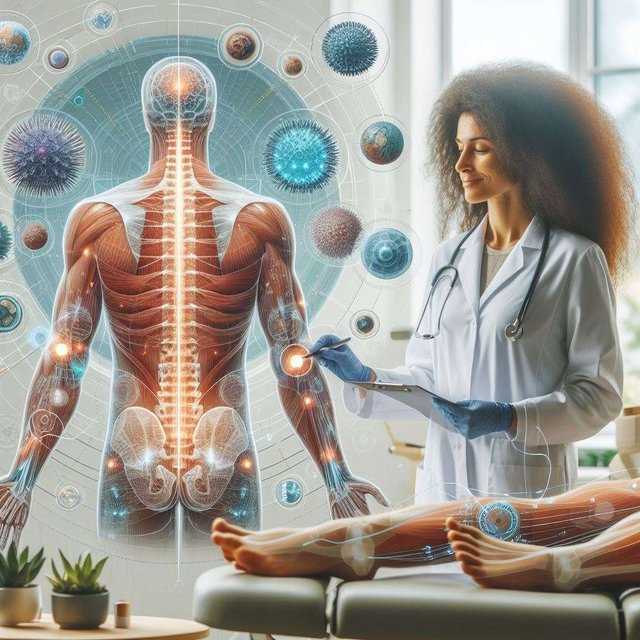Revolutionizing Physiotherapy

Blending Technology with Traditional Healing
The terms physiotherapy and physical therapy are often used interchangeably, even though they have different but complementary roles in healthcare. Physiotherapy relies on ancient healing traditions that use natural energies like sunlight, water, climate, and movement. These methods—such as physical exercise, hydrotherapy, and balneotherapy—aim to support the body's natural healing processes. In contrast, physical therapy uses a more targeted approach, applying artificial energies like electrical stimulation, ultrasound, and laser to directly promote tissue regeneration.
The development of physical therapy is closely linked to technological innovations that have opened up new possibilities for enhancing therapeutic effectiveness. Ultrasound treatments are now more advanced, modulating frequency, intensity, and amplitude for more targeted and individualized care. Soft laser therapy offers similar benefits: the proper choice of wavelength and intensity helps control biological responses in different tissues more accurately. These advancements significantly enhance therapeutic outcomes, especially for acute injuries and chronic conditions requiring quick, focused intervention.
Frequency-based electrotherapy has also made significant progress. By modulating the current's frequency, treatments can be tailored to patient needs, allowing for muscle relaxation, increased muscle strength, or reduced inflammation. While traditional manual techniques like massage and mobilization have always been essential, modern physical therapy integrates precise electrotherapy methods that often replace or supplement older techniques.
Physical Therapy: Essential Support for a Healthy Life
Electrotherapy uses electrical currents of varying frequencies to stimulate muscles, relieve pain, and reduce inflammation. It creates specifically regulated current patterns that impact the body in a targeted way. Electrotherapy aims not only to reduce pain but also to stimulate muscle regeneration, supporting the body's natural healing processes.
Ultrasound therapy takes this further by using high-frequency sound waves that affect not only surface tissues but also deeper structures. The micro-massage effect of ultrasound therapy stimulates circulation, reduces inflammation, and encourages cell regeneration. This is particularly valuable for joint issues and muscle injuries. Another key benefit of ultrasound therapy is its ability to significantly shorten rehabilitation time, making it particularly attractive to athletes and physically active individuals.
Heat and cold therapies are also crucial in physical therapy. Cold therapy effectively reduces inflammation and swelling, while heat therapy improves circulation, relaxes muscles, and alleviates pain. Modern infrared light techniques further boost the effectiveness of these treatments by reaching deeper tissue layers, enhancing rehabilitation outcomes.
Shockwave therapy is another modern tool, using acoustic waves to stimulate tissue regeneration. These mechanical impulses improve blood flow and metabolism, making shockwave therapy effective for conditions like chronic tendonitis, heel pain, and joint problems. This quick, efficient method helps patients return to daily activities faster.
New Opportunities in Modern Physical Therapy
Today's technology has opened up incredible opportunities in physical therapy. Innovative methods like electrical stimulation, ultrasound, and laser treatments target self-healing processes and maximize effectiveness. These devices can be adjusted with remarkable precision, allowing for individualized treatment strategies, which represents significant progress over traditional manual techniques.
Advanced ultrasound modulation—adjusting intensity and frequency—enables precise interventions. Ultrasound can be tailored to different tissue structures, whether superficial or deep. Laser and light therapies also use a specific approach: light energy of the correct wavelength effectively reduces inflammation and promotes wound healing. For example, the combination of blue and red light is particularly useful for cell regeneration and inflammation reduction.
Soft laser therapy plays an important role as it can penetrate deeper tissue layers, stimulating collagen production, which is crucial for maintaining healthy tissue structure and elasticity. This therapy is especially effective for chronic inflammation, joint pain, and other musculoskeletal problems, helping patients return to active life more quickly.
Impact of Physical Therapy on Quality of Life
The goal of physical therapy is not only to relieve pain but also to enhance the overall quality of life. Improved mobility, increased muscle strength, and better coordination are key factors for leading a fulfilling life. Modern physical therapy helps patients return to daily activities faster, gain independence, and reduce physical limitations.
Regular physical therapy helps maintain physical and mental balance. Improved muscle elasticity, increased range of joint motion, and reduced tension all contribute to better overall well-being. These improvements have a direct impact on mental health: reduced pain, restored mobility, and increased physical activity boost self-confidence, positively affecting daily activities and overall quality of life.
Physical therapy also plays a key role in treating acute injuries, easing chronic pain, and facilitating post-surgical rehabilitation. Thanks to modern technologies, today's procedures are more precise and targeted than ever. Regular therapy also aids in prevention, helping avoid future injuries and musculoskeletal issues, thereby improving patients' long-term quality of life.
Looking Forward
The ongoing technological advancement in physical therapy continues to open new possibilities. To benefit from the most modern treatment methods, consulting with a specialist who offers advanced, individualized care is essential. With the help of technology, faster, more targeted, and effective recovery is now possible. By using modern physical therapy methods, we can significantly enhance our quality of life and overall well-being.
Consulting a physician and creating a personalized treatment plan are vital for successful therapy. Active participation, motivation, and patient involvement are crucial for full recovery. The broad spectrum of modern physical therapy allows interventions to be conducted with greater precision and efficiency. Let us leverage available technological advancements to achieve the best possible physical and mental health.